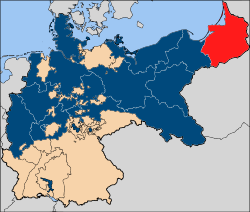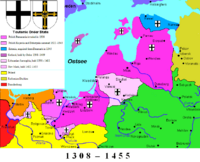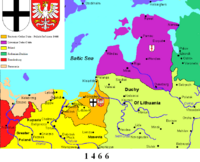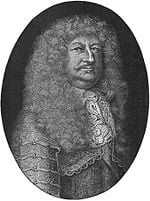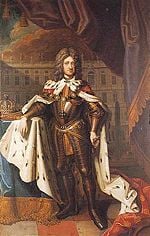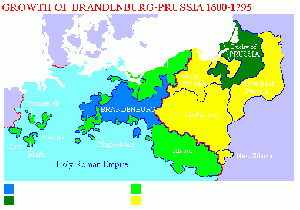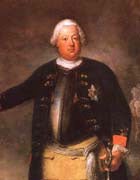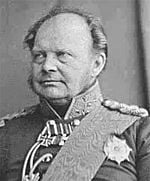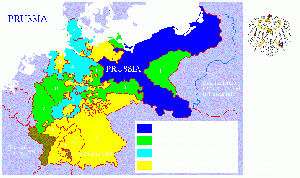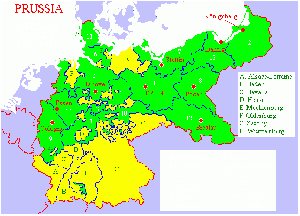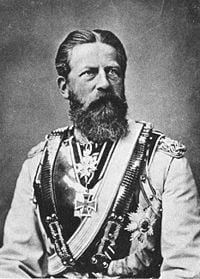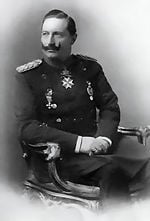Prussia
Prussia Latin: Borussia, Prutenia; Old Prussian: Prūsa) was, most recently, a historic state originating in Brandenburg, an area that for centuries had substantial influence on German and European history. The last capital of Prussia was Berlin. Prussia attained its greatest importance in the eighteenth and nineteenth centuries. During the eighteenth century, it became a great European power under the reign of Frederick II of Prussia (1740–1786). During the nineteenth century, Prime Minister Otto von Bismarck pursued a policy of uniting the German principalities into a "Kleindeutsche Lösung" (Lesser Germany) that would exclude the Austrian Empire. Impetus towards reunification came from Napoleon Bonaparte, whose vision for Europe was of unified nations states based on the French model. Subsequently, as the idea of a united Germany (resurrecting the days of the Holy Roman Empire) gained popularity, the unification of Germany in 1871, with Prussia forming the core of the German Empire. Creation of the unified German states weakened both Austria-Hungary and France.
For some time, when Austria vied with Prussia to initiate unification, it was an open questions whether Austria or Prussia would dominate the new polity. Had Austria done so, instead of being excluded, history may have followed a different course. Although the Habsburg's ruled autocratically, by the end of the nineteenth century the Empire was developing democratic institutions.[1] Also, by definition, it was a multi-cultural state in which German, Hungarian, Polish, Italian and several other languages were spoken.[2] In contrast, Prussia had an ethos that has been described as “Prussian spirit” - which refers to its militaristic spirit; Prussia has been characterized as an army with a country rather than as a country with an army. This ethos re-emerged in Adolf Hitler's Third Reich. Frederick II of Prussia's desire to glorify and aggrandize his state and himself may well have helped to create the space within which Nazi ideology of Germany as a superior and imperial power could take root.
Meaning of the Word "Prussia"
In the course of its history, Prussia has had various meanings:
- The land of the Baltic Prussians, so-called Old Prussia (prior to the thirteenth century): conquered by the Teutonic Knights and gradually Christianized, Germanized and Polonized - this region is now situated in parts of southern Lithuania, the Kaliningrad exclave of Russia, and north-eastern Poland;
- Royal Prussia (1466 – 1772): territory awarded to Poland after its victory over the Teutonic Order in the Thirteen Years' War;
- The Duchy of Prussia (1525 – 1701): a territory formed by the secularization of the Monastic State of the Teutonic Knights, originally under the sovereignty of Poland, later ruled by the Hohenzollern margraves and electors of Brandenburg;
- Brandenburg-Prussia (1618 – 1701): a personal union between the Hohenzollern rulers of Ducal Prussia and the Margraviate of Brandenburg;
- The Kingdom of Prussia (1701 - 1918): formed the elevation of Brandenburg-Prussia to a kingdom, this state went on to become the dominant state of the German Empire (1871-1918);
- The Province of Prussia (1829 - 1878): a province of the Kingdom of Prussia, created from the merger of the provinces East Prussia and West Prussia;
- The Free State of Prussia (1918 - 1947): the republic state of Weimar Germany formed after the dissolution of the Hohenzollern monarchy at the end of World War I. Prussia as a state was abolished de facto by the Nazis in 1934 and de jure by the Allied Control Council in 1947 in the aftermath of World War II.
Since then, the term's relevance has been limited to historical, geographical, or cultural usages. Even today, a certain kind of ethic is called "Prussian virtues," for instance: perfect organization, sacrifice, rule of law, obedience to authority, and militarism, but also reliability, religious tolerance, sobriety, pragmatism, thriftiness, punctuality, modesty, and diligence. Many Prussians believed that these virtues promoted the rise of their country.
Symbols
The black and white national colors of Prussia stem from the Teutonic Knights, who wore a white coat embroidered with a black cross. The combination of these colors with the white and red Hanseatic colors of the free cities Bremen, Hamburg, and Lübeck resulted in the black-white-red commercial flag of the North German Confederation, which became the flag of the German Empire in 1871.
From the Protestant Reformation onward, the Prussian motto was Suum cuique ("to each, his own"; German: Jedem das Seine). Additionally, it was the motto of the Order of the Black Eagle, created by King Frederick I (see also Iron Cross).
The main coat of arms of Prussia, as well as the Flag of Prussia depicted a black eagle on a white background.
Geography and population
Prussia began as a small territory in what was later called East Prussia, which is now divided into the Warmian-Masurian Voivodeship of Poland, the Kaliningrad Oblast exclave of Russia, and the Klaipėda Region of Lithuania. The region, originally populated by Baltic Old Prussians who were Christianized and Germanized, became a preferred location for immigration by (later mainly Protestant) Germans as well as Poles and Lithuanians along border regions.
Before its abolition, the territory of the Kingdom of Prussia included "Prussia proper" (West and East Prussia), Brandenburg, the Province of Saxony (including most of the present-day state of Saxony-Anhalt and parts of the state of Thuringia in Germany), Pomerania, Rhineland, Westphalia, Silesia (without Austrian Silesia), Lusatia, Schleswig-Holstein, Hanover, Hesse-Nassau, and some small detached areas in the south such as Hohenzollern, the ancestral home of the Prussian ruling family.
In 1914, Prussia had an area of 354,490 km². In May 1939 Prussia had an area of 297,007 km² and a population of 41,915,040 inhabitants. The Principality of Neuenburg, now the Canton of Neuchâtel in Switzerland, was a part of the Prussian kingdom from 1707 to 1848.
Prussia was predominantly a Protestant German state. East Prussia's southern region of Masuria was largely made up of Germanized Protestant Masurs. This explains in part why the Catholic South German states, especially Austria and Bavaria, resisted Prussian hegemony for so long.
There were substantial Roman Catholic populations in the Rhineland and parts of Westphalia. Also West Prussia, Warmia, Silesia, and the Province of Posen had predominantly Catholic populations. The Kingdom of Prussia acquired these areas from countries with a Catholic majority: the Kingdom of Poland and the Austrian Empire.
The area of Greater Poland where the Polish nation had originated became the Province of Posen after the Partitions of Poland. Poles in this Polish-majority province (62 percent Polish, 38 percent German) resisted German rule. Also, the southeast portion of Silesia (Upper Silesia) had a large Polish population.
As a result of the Treaty of Versailles in 1919 the Second Polish Republic regained these two areas, but also areas with a German majority in the Province of West Prussia. After World War II, East Prussia, Silesia, most of Pomerania, and part of Brandenburg were taken over by either the Soviet Union or Poland.[3]
Early history
In 1226 Duke Konrad I of Masovia invited the Teutonic Knights, a German military order of crusading knights, headquartered in the Kingdom of Jerusalem at Acre, to conquer the Baltic Prussian tribes on his borders. During 60 years of struggles against the Old Prussians, the order created an independent state which came to control Prussia. After the Livonian Brothers of the Sword joined the Teutonic Order in 1237 they also controlled Livonia (now Latvia and Estonia) and western Lithuania.
The Knights were subordinate only to the pope and the emperor. Their initially close relationship with the Polish Crown deteriorated completely after they conquered Polish-claimed Pomerelia and Danzig (Gdańsk), a town mainly populated by German settlers. The Knights were eventually defeated in the Battle of Grunwald in 1410 by Poland and Lithuania, allied through the Union of Krewo.
The Thirteen Years' War (1454-1466) began when the Prussian Confederation, a coalition of Hanseatic cities of western Prussia, rebelled against the Order and requested help from the Polish king. The Teutonic Knights were forced to acknowledge the sovereignty of King Casimir IV Jagiellon of Poland in the Peace of Thorn, losing western Prussia (Royal Prussia) to Poland in the process.
In 1525, Grand Master Albert of Brandenburg-Ansbach, a member of a cadet branch of the House of Hohenzollern, became a Lutheran Protestant and secularized the Order's remaining Prussian territories into the Duchy of Prussia. This was the area east of the mouth of the Vistula River, later sometimes called "Prussia proper." For the first time, these lands were in the hands of a branch of the Hohenzollern family, rulers of the Margraviate of Brandenburg to the west, a German state centered on Berlin and ruled since the 15th century by the Hohenzollern dynasty. Furthermore, with his renunciation of the Order, Albert could now marry and produce offspring.
Brandenburg and Prussia were unified two generations later. Anna, granddaughter of Albert I and daughter of Duke Albert Frederick (reigned 1568-1618), married her cousin Elector John Sigismund of Brandenburg.
Upon the death of Albert Frederick in 1618, who died without male heirs, John Sigismund was granted the right of succession to the Duchy of Prussia, which was still a Polish fief. From this time the Duchy of Prussia was in personal union with the Margraviate of Brandenburg. The resulting state, known as Brandenburg-Prussia, consisted of geographically disconnected territories in Prussia, Brandenburg, and Rhenish lands of Cleves and Mark.
During the Thirty Years' War, the disconnected Hohenzollern lands were repeatedly marched across by various armies, especially the occupying Swedes. The ineffective and militarily weak Margrave George William (1619-1640) fled from Berlin to Königsberg, the historic capital of the Duchy of Prussia, in 1637. His successor, Frederick William (1640-1688), reformed the army to defend the lands.
Frederick William went to Warsaw in 1641 to render homage to King Władysław IV Vasa of Poland for the Duchy of Prussia, which was still held in fief from the Polish crown. Later, he managed to obtain a discharge from his obligations as a vassal to the Polish king by taking advantage of the difficult position of Poland vis-á-vis Sweden in the Northern Wars and his friendly relations with Russia during a series of Russo-Polish wars. He was finally given full sovereignty over Prussia in the Treaty of Wehlau in 1657.
Kingdom of Prussia
On January 18, 1701, Frederick William's son, Elector Frederick III, upgraded Prussia from a duchy to a kingdom, and crowned himself King Frederick I. To avoid offending Leopold I, emperor of the Holy Roman Empire where most of his lands lay, Frederick was only allowed to title himself "King in Prussia," not "King of Prussia." However, Brandenburg was treated in practice as part of the Prussian kingdom rather than a separate state.
The state of Brandenberg-Prussia became commonly known as "Prussia," although most of its territory, in Brandenburg, Pomerania, and western Germany, lay outside of Prussia proper. The Prussian state grew in splendor during the reign of Frederick I, who sponsored the arts at the expense of the treasury.
He was succeeded by his son, Frederick William I (1713-1740) the austere "Soldier King," who did not care for the arts but was thrifty and practical. He is considered the creator of the vaunted Prussian bureaucracy and the standing army, which he developed into one of the most powerful in Europe, although his troops only briefly saw action during the Great Northern War. In view of the size of the army in relation to the total population, Voltaire said later: "Where some states have an army, the Prussian Army has a state!" Also, Frederick William settled more than 20,000 Protestant refugees from Salzburg in thinly populated eastern Prussia, which was eventually extended to the west bank of the Memel river, and other regions. From Sweden he acquired Western Pomerania as far as the Peene in 1720.
In 1740, Frederick William was succeeded by his son, Frederick II, later nicknamed "Frederick the Great." As crown prince he focused on philosophy and the arts; yet, in the first year of his reign he ordered the Prussian army to march into Silesia, a possession of Habsburg Austria to which the Hohenzollerns laid claim based on an old and disputed treaty of succession. In the three Silesian Wars (1740-1763) Frederick succeeded in conquering Silesia from Austria and holding his new possession. In the last, the Seven Years' War, he held it against a coalition of Austria, France, and Russia. Voltaire, a close friend of the king, once described Frederick the Great's Prussia by saying " …it was Sparta in the morning, Athens in the afternoon." From these wars onwards the German dualism dominated German politics until 1866.
Silesia, a region of rich soils and prosperous manufacturing towns, greatly increased the area, population, and wealth of Prussia. Success on the battleground against Austria and other powers proved Prussia's status as one of the great powers of Europe. The Silesian Wars began more than a century of rivalry and conflict between Prussia and Austria as the two most powerful states operating within the Holy Roman Empire (although, ironically, both had extensive territory outside the empire). In 1744 the County of East Frisia fell to Prussia following the extinction of its ruling Cirksena dynasty.
In the last 23 years of his reign until 1786, Frederick II, who understood himself as the "first servant of the state," promoted the development of Prussian areas such as the Oderbruch. At the same time he built up Prussia's military power and participated in the First Partition of Poland with Austria and Russia (1772), an act that geographically connected the Brandenburg territories with those of Prussia proper. During this period, he also opened Prussia's borders to immigrants fleeing from religious persecution in other parts of Europe, such as the Huguenots. Prussia became a safe haven in much the same way that the United States welcomed immigrants seeking freedom in the 19th century.
Frederick the Great, the first "King of Prussia," practiced enlightened absolutism. He introduced a general civil code, abolished torture, and established the principle that the crown would not interfere in matters of justice. He also promoted an advanced secondary education, the forerunner of today's German gymnasium (grammar school) system, which prepares the brightest students for university studies. The Prussian education system became emulated in various countries.
Napoleonic Wars
During the reign of King Frederick William II (1786-1797), Prussia annexed additional Polish territory through further Partitions of Poland. His successor, Frederick William III (1797-1840), announced the union of the Prussian Lutheran and Reformed churches into one church.
Prussia took a leading part in the French Revolutionary Wars, but remained quiet for more than a decade due to the Peace of Basel of 1795, only to go once more to war with France in 1806 as negotiations with that country over the allocation of the spheres of influence in Germany failed. Prussia suffered a devastating defeat against Napoleon Bonaparte's troops in the Battle of Jena-Auerstedt, leading Frederick William III and his family to flee temporarily to Memel. Under the Treaties of Tilsit in 1807, the state lost about half of its area, including the areas gained from the second and third Partitions of Poland, which now fell to the Duchy of Warsaw. Beyond that, the king was obliged to make an alliance with France and join the Continental System.
In response to this defeat, reformers such as Stein and Hardenberg set about modernizing the Prussian state. Among their reforms were the liberation of peasants from serfdom, the emancipation of Jews and making full citizens of them, and the institution of self-administration in municipalities. The school system was rearranged, and in 1818 free trade was introduced. The process of army reform ended in 1813 with the introduction of compulsory military service.
After the defeat of Napoleon in Russia, Prussia quit its alliance with France and took part in the Sixth Coalition during the "Wars of Liberation" (Befreiungskriege) against the French occupation. Prussian troops under Marshal Gebhard Leberecht von Blücher contributed crucially in the Battle of Waterloo of 1815 to the final victory over Napoleon. Prussia's reward in 1815 at the Congress of Vienna was the recovery of her lost territories, as well as the whole of the Rhineland, Westphalia, and some other territories. These western lands were to be of vital importance because they included the Ruhr Area, the center of Germany's fledgling industrialization, especially in the arms industry. These territorial gains also meant the doubling of Prussia's population. In exchange, Prussia withdrew from areas of central Poland to allow the creation of Congress Poland under Russian sovereignty.
Prussia emerged from the Napoleonic Wars as the dominant power in Germany, overshadowing her long-time rival Austria, which had given up the imperial crown in 1806. In 1815 Prussia became part of the German Confederation.
The first half of the nineteenth century saw a prolonged struggle in Germany between liberals, who wanted a united, federal Germany under a democratic constitution, and conservatives, who wanted to maintain Germany as a patchwork of independent, monarchical states, with Prussia and Austria competing for influence. Because of Prussia's size and economic importance, smaller states began to join its free trade area in the 1820s. Prussia benefited greatly from the creation in 1834 of the German Customs Union (Zollverein), which included most German states but excluded Austria.
In 1848 the liberals saw an opportunity when revolutions broke out across Europe. Alarmed, King Frederick William IV agreed to convene a National Assembly and grant a constitution. When the Frankfurt Parliament offered Frederick William the crown of a united Germany, he refused on the grounds that he would not accept a crown from a revolutionary assembly without the sanction of Germany's other monarchs.
The Frankfurt Parliament was forced to dissolve in 1849, and Frederick William issued Prussia's first constitution by his own authority in 1850. This conservative document provided for a two-house parliament. The lower house, or Landtag was elected by all taxpayers, who were divided into three classes whose votes were weighted according to the amount of taxes paid. Women and those who paid no taxes had no vote. This allowed just over one-third of the voters to choose 85 percent of the legislature, all but assuring dominance by the more well-to-do men of the population. The upper house, which was later renamed the Herrenhaus ("House of Lords"), was appointed by the king. He retained full executive authority and ministers were responsible only to him. As a result, the grip of the landowning classes, the Junkers, remained unbroken, especially in the eastern provinces.
Wars of unification
In 1862 King William I appointed Otto von Bismarck as Prime Minister of Prussia. Bismarck was determined to defeat both the liberals and the conservatives by creating a strong united Germany but under the domination of the Prussian ruling class and bureaucracy, not a liberal democracy. Bismarck realized that the Prussian crown could win the support of the people only if he himself took the lead in the fight for the German unification. So he guided Prussia through three wars which together brought William the position of German Emperor.
The Schleswig Wars
The Kingdom of Denmark was at the time in personal union with the Duchies of Schleswig and Holstein, both of which had close ties with each other, although only Holstein was part of the German Confederation. When the Danish government tried to integrate Schleswig, but not Holstein, into the Danish state, Prussia led the German Confederation against Denmark in the First War of Schleswig (1848-1851). Although the Danes were defeated militarily, the European great powers pressured Prussia into returning Schleswig and Holstein to Denmark, in return for assurances that the Danes would not try to integrate Schleswig again. Because Russia supported Austria, Prussia was also conceded predominance in the German Confederation to Austria in the Punctation of Olmütz in 1850.
In 1863, Denmark introduced a shared constitution for Denmark and Schleswig. This led to conflict with the German Confederation, which authorized the occupation of Holstein by the Confederation, from which Danish forces withdrew. In 1864, Prussian and Austrian forces crossed the border between Holstein and Schleswig initiating the Second War of Schleswig. The Austro-Prussian forces defeated the Danes, who surrendered both territories. In the resulting Gastein Convention of 1865 Prussia took over the administration of Schleswig while Austria assumed that of Holstein.
Austro-Prussian War
Bismarck realized that the dual administration of Schleswig and Holstein was only a temporary solution, and tensions escalated between Prussia and Austria. The struggle for supremacy in Germany then led to the Austro-Prussian War (1866), triggered by the dispute over Schleswig and Holstein.
On the side of Austria stood the southern German states (including Bavaria and Württemberg), some central German states (including Saxony), and Hanover in the north; on the side of Prussia were Italy, most northern German states, and some smaller central German states. Eventually, the better-armed Prussian troops won the crucial victory at the battle of Königgrätz under Helmuth von Moltke the Elder. The century-long struggle between Berlin and Vienna for dominance of Germany was now over.
Bismarck desired Austria as an ally in the future, and so he declined to annex any Austrian territory. But in the Peace of Prague in 1866, Prussia annexed four of Austria's allies in northern and central Germany—Hanover, Hesse-Kassel, Nassau and Frankfurt. Prussia also won full control of Schleswig-Holstein. As a result of these territorial gains, Prussia now stretched uninterrupted across the northern two-thirds of Germany and contained two-thirds of Germany's population. The German Confederation was dissolved, and Prussia cajoled the 21 states north of the Main River into forming the North German Confederation.
Prussia was the dominant state in the new confederation, as the kingdom comprised almost four-fifths of the new state's territory and population. Prussia's near-total control over the confederation was cemented in the constitution drafted for it by Bismarck in 1867. Executive power was held by a president, assisted by a chancellor responsible only to him. The presidency was a hereditary office of the Hohenzollern rulers of Prussia. There was also a two-house parliament. The lower house, or Reichstag (Diet), was elected by universal male suffrage. The upper house, or Bundesrat (Federal Council) was appointed by the state governments. The Bundesrat was, in practice, the stronger chamber. Prussia had 17 of 43 votes, and could easily control proceedings through alliances with the other states.
As a result of the peace negotiations, the states south of the Main remained theoretically independent, but received the (compulsory) protection of Prussia. Additionally, mutual defense treaties were concluded. (See also "Das Lied der Deutschen".) However, the existence of these treaties was kept secret until Bismarck made them public in 1867, when France tried to acquire Luxembourg.
Franco-Prussian War
The controversy with the Second French Empire over the candidacy of a Hohenzollern to the Spanish throne was escalated both by France and Bismarck. With his Ems Dispatch, Bismarck took advantage of an incident in which the French ambassador had approached William. The government of Napoleon III, expecting another civil war among the German states, declared war against Prussia, continuing Franco-German enmity. Honoring their treaties, the German states joined forces and quickly defeated France in the Franco-Prussian War in 1870. Following victory under Bismarck's and Prussia's leadership, Baden, Württemberg, and Bavaria—which had remained outside the North German Confederation—accepted incorporation into a united German Empire.
The empire was a Kleindeutsche Lösung—or a "Lesser German Solution" to the problem of German unity, because it excluded Austria, which remained connected to Hungary. On January 18, 1871 (the 170th anniversary of the coronation of King Frederick I), William was proclaimed "German Emperor" (not "Emperor of Germany") in the Hall of Mirrors at Versailles outside Paris, while the French capital was still under siege.
German Empire
The two decades after the unification of Germany were the peak of Prussia's fortunes, but the seeds for potential strife were built into the Prusso-German political system.
The constitution of the German Empire was a slightly amended version of the North German Confederation's constitution. Officially, the German Empire was a federal state. In practice, Prussia's dominance over the empire was almost absolute. The Hohenzollern kingdom included three-fifths of its territory and two-thirds of its population. The Imperial German Army was, in practice, an enlarged Prussian army, although the other kingdoms (Bavaria, Saxony, and Württemberg) retained their own armies. The imperial crown was a hereditary office of the House of Hohenzollern, the royal house of Prussia. The prime minister of Prussia was, except for two brief periods (January-November 1873 and 1892-1894), also imperial chancellor. While all men above age 25 were eligible to vote in imperial elections, Prussia retained its restrictive three-class voting system. This effectively required the king/emperor and prime minister/chancellor to seek majorities from legislatures elected by two completely different franchises. In both the kingdom and the empire, the original constituencies were never redrawn to reflect changes in population, meaning that rural areas were grossly overrepresented by the turn of the century.
As a result, Prussia and the German Empire were something of a paradox. Bismarck knew that his new Reich was now a colossus out of all proportion to the rest of the Continent. With this in mind, he declared Germany a satisfied power, using his talents to preserve peace, for example at the Congress of Berlin.
Frederick III may have had the potential to be a leader in Bismarck's mold, but he was already terminally ill when he became emperor for 99 days in 1888 upon the death of his father. He was married to Victoria, the first daughter of Queen Victoria of the United Kingdom, but their first son William suffered physical and possibly mental damage during birth.
At age 29, William became Emperor William II after a difficult youth and conflicts with his British mother. He turned out to be a man of limited experience, narrow and reactionary views, poor judgment, and occasional bad temper, which alienated former friends and allies. William, who was a close relative of the British and Russian royal families, became their rival and ultimately their enemy.
After forcing Bismarck out in 1890, William embarked on a program of militarization and adventurism in foreign policy that eventually led Germany into isolation. A misjudgment of the conflict with Serbia by the emperor, who left for holidays, and the hasty mobilization plans of several nations led to the disaster of World War I (1914–1918). As the price of their withdrawal from the war, the Bolsheviks conceded large regions of the western Russian Empire, some of which bordered Prussia, to German control in the Treaty of Brest-Litovsk (1918). German control of these territories lasted only for a few months, however, because of the defeat of German military forces by the western Allies and the German Revolution. The post-war Treaty of Versailles, which held Germany solely responsible for the war, was signed in Versailles' Hall of Mirrors, where the German Empire had been created.
Free State of Prussia in the Weimar Republic
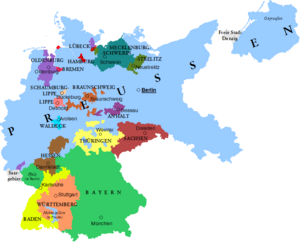
Because of the German Revolution of 1918, William II abdicated as German Emperor and King of Prussia. Prussia was proclaimed a "Free State" (i.e. a republic, German: Freistaat) within the new Weimar Republic and in 1920 received a democratic constitution.
All of Germany's territorial losses, specified in the Treaty of Versailles, were areas that had been part of Prussia: Alsace-Lorraine to France; Eupen and Malmedy to Belgium; North Schleswig to Denmark; the Memel Territory to Lithuania; the Hultschin area to Czechoslovakia. Many of the areas which Prussia had annexed in the partitions of Poland, such as the Provinces of Posen and West Prussia, as well as eastern Upper Silesia, went to the Second Polish Republic. Danzig became the Free City of Danzig under the administration of the League of Nations. Also, the Saargebiet was created mainly from formerly Prussian territories.
As before the partitions of Poland, because of this lost territory, there was no longer a land connection between East Prussia and the rest of the country; and East Prussia could now only be reached by ship ("shipping service East Prussia") or by a railway through the Polish corridor.
The German government seriously considered breaking up Prussia into smaller states, but eventually traditionalist sentiment prevailed and Prussia became by far the largest state of the Weimar Republic, comprising 60 percent of its territory. With the abolition of the old Prussian franchise, it became a stronghold of the left. Its incorporation of "Red Berlin" and the industrialized Ruhr Area—both with working-class majorities—ensured left-wing dominance.
From 1919 to 1932, Prussia was governed by a coalition of the Social Democrats, Catholic Centre, and German Democrats; from 1921 to 1925, coalition governments included the German People's Party. Unlike in other states of the German Reich, majority rule by democratic parties in Prussia was never endangered. Nevertheless, in East Prussia and some industrial areas, the National Socialist German Workers Party (or Nazi Party) of Adolf Hitler gained more and more influence and popular support, especially from the lower middle class. Except for Roman Catholic Prussian Upper Silesia, the Nazi Party in 1932 became the largest party in most parts of the Free State of Prussia. However, the democratic parties in coalition remained a majority, while Communists and Nazis were in the opposition.
The East Prussian Otto Braun, who was Prussian minister-president almost continuously from 1920 to 1932, is considered one of the most capable Social Democrats in history. He implemented several trend-setting reforms together with his minister of the interior, Carl Severing, which were also models for the later Federal Republic of Germany (FRG). For instance, a Prussian minister-president could be forced out of office only if there was a "positive majority" for a potential successor. This concept, known as the constructive vote of no confidence, was carried over into the Basic Law of the FRG. Most historians regard the Prussian government during this time as far more successful than that of Germany as a whole.
In marked contrast to its prewar authoritarianism, Prussia was a pillar of democracy in the Weimar Republic. This system was destroyed by the Preußenschlag ("Prussian coup") of Reich Chancellor Franz von Papen. In this coup d'etat, the government of the Reich unseated the Prussian government on July 20, 1932, under the pretext that the latter had lost control of public order in Prussia (during the Bloody Sunday of Altona, Hamburg, which was still part of Prussia at that time). Papen appointed himself Reich commissioner for Prussia and took control of the government. The Preußenschlag made it easier, only half a year later, for Adolf Hitler to take power decisively in Germany, since he had the whole apparatus of the Prussian government, including the police, at his disposal.
The End of Prussia
After the appointment of Adolf Hitler as the new chancellor, the Nazis used the opportunity of the absence of Franz von Papen to appoint Hermann Göring federal commissioner for the Prussian ministry of the interior. The Reichstag election of March 5, 1933 strengthened the position of the National Socialist Party, although they did not achieve an absolute majority.
Because the Reichstag building had been set on fire a few weeks earlier, the new Reichstag was opened in the Garrison Church of Potsdam on March 21, 1933 in the presence of President Paul von Hindenburg. In a propaganda-filled meeting between Hitler and the Nazi Party, the "marriage of old Prussia with young Germany" was celebrated, to win over the Prussian monarchists, conservatives, and nationalists and induce them to vote for the Enabling Act of 1933.
In the centralized state created by the Nazis in the "Law on the Reconstruction of the Reich" ("Gesetz über den Neuaufbau des Reiches," January 30, 1934) and the "Law on Reich Governors" ("Reichsstatthaltergesetz," January 30, 1935) the states were dissolved, in fact if not in law. The federal state governments were now controlled by governors for the Reich who were appointed by the chancellor. Parallel to that, the organization of the party into districts (Gaue) gained increasing importance, as the official in charge of a Gau (the head of which was called a Gauleiter) was again appointed by the chancellor who was at the same time chief of the Nazi Party.
In Prussia, this anti-federalist policy went even further. From 1934 almost all ministries were merged and only a few departments were able to maintain their independence. Hitler himself became formally the governor of Prussia. His functions were exercised, however, by Hermann Göring, as Prussian prime minister.
As provided for in the "Greater Hamburg Law" ("Groß-Hamburg-Gesetz"), certain exchanges of territory took place. Prussia was extended on April 1, 1937, for instance, by the incorporation of the Free and Hanseatic City of Lübeck.
The Prussian lands transferred to Poland after the Treaty of Versailles were re-annexed during World War II. However, most of this territory was not reintegrated back into Prussia but assigned to separate Gaue of Nazi Germany.
With the end of National Socialist rule in 1945 came the division of Germany into Zones of Occupation, and the transfer of control of everything east of the Oder-Neisse line, (including Silesia, Farther Pomerania, Eastern Brandenburg, and southern East Prussia), to Poland, with the northern third of East Prussia, including Königsberg, now Kaliningrad, going to the Soviet Union. Today the Kaliningrad Oblast is a Russian exclave between Lithuania and Poland. An estimated ten million Germans fled or were expelled from these territories as part of the German exodus from Eastern Europe.
In Law #46 of February 25, 1947 the Allied Control Council formally proclaimed the dissolution of the remains of the Prussian state. In the Soviet Zone of Occupation, which became East Germany in 1949, the former Prussian territories were reorganized into the states of Brandenburg and Saxony-Anhalt, with the remaining parts of the Province of Pomerania going to Mecklenburg-Western Pomerania. These states were abolished in 1952 in favor of districts, but were recreated after the fall of communism in 1990.
In the Western Zones of occupation, which became West Germany in 1949, the former Prussian territories were divided up among North Rhine-Westphalia, Lower Saxony, Hesse, Rhineland-Palatinate, and Schleswig-Holstein. Württemberg-Baden and Württemberg-Hohenzollern were later merged with Baden to create the state of Baden-Württemberg.
Since the dissolution of the Soviet Union, a small number of ethnic Germans from Kazakhstan have begun to settle in the Kaliningrad exclave of Russia, once northern East Prussia, as part of the migration influx into the area, which was previously a restricted area (closed city). As of 2005, about 6000 (0.6 percent of population) ethnic Germans, mostly from other parts of Russia, live there.
After German reunification in 1990, a plan was developed to merge the States of Berlin and Brandenburg. Though some suggested calling the proposed new state "Prussia," no final name was proposed, and the combined state would probably have been called either "Brandenburg" or "Berlin-Brandenburg." However this proposed merger was rejected in 1996 by popular vote, achieving a majority of votes only in former West Berlin.
Notes
- ↑ Dominic Lieven. 2002. Empire: The Russian Empire and Its Rivals. (New Haven, CT: Yale University Press. ISBN 0300097263), 193. Lieven comments that by "1900, to a "unique extent" Austro-Hungary was becoming "a multi-national democratic federation, able to offer its peoples the economic benefits of a huge market, legally protected equality in status, and the security that was the Empire's traditional boon."
- ↑ Austria-Hungary consisted of the following ethnic groups: The ethnic distribution of Austria-Hungary
- German 24 percent
- Hungarian 20 percent
- Czech 13 percent
- Polish 10 percent
- Ruthenian 8 percent
- Romanian 6 percent
- Croat 5 percent
- Slovak 4 percent
- Serb 4 percent
- Slovene 3 percent
- Italian 3 percent
- ↑ Genealogy and Poland. PolishRoots.com. Retrieved July 14, 2008.
ReferencesISBN links support NWE through referral fees
- Brunschwig, Henri. 1974. Enlightenment and romanticism in eighteenth-century Prussia. Chicago, IL: University of Chicago Press. ISBN 9780226077680.
- Carsten, F.L. 1981. The origins of Prussia. Westport, CT: Greenwood. ISBN 9780313232206.
- Clark, Christopher M. 2006. Iron kingdom: the rise and downfall of Prussia, 1600-1947. Cambridge, MA: Belknap Press of Harvard University Press. ISBN 9780674023857.
- Craig, Gordon Alexander. 1984. The end of Prussia. (The Curti lectures, 1982) Madison, WI: University of Wisconsin Press. ISBN 9780299097301.
- Koch, H. W. 1978. A history of Prussia. London, UK: Longman. ISBN 9780582481893.
- Lieven, Dominic. 2002. Empire: The Russian Empire and Its Rivals. New Haven, CT: Yale University Press. ISBN 0300097263.
External links
All links retrieved December 2, 2022.
- Provinces - Rulers.org.
- Foundation for Prussian Palaces and Gardens Berlin-Brandenburg - spsg.de.
Former Countries
Credits
New World Encyclopedia writers and editors rewrote and completed the Wikipedia article in accordance with New World Encyclopedia standards. This article abides by terms of the Creative Commons CC-by-sa 3.0 License (CC-by-sa), which may be used and disseminated with proper attribution. Credit is due under the terms of this license that can reference both the New World Encyclopedia contributors and the selfless volunteer contributors of the Wikimedia Foundation. To cite this article click here for a list of acceptable citing formats.The history of earlier contributions by wikipedians is accessible to researchers here:
The history of this article since it was imported to New World Encyclopedia:
Note: Some restrictions may apply to use of individual images which are separately licensed.
